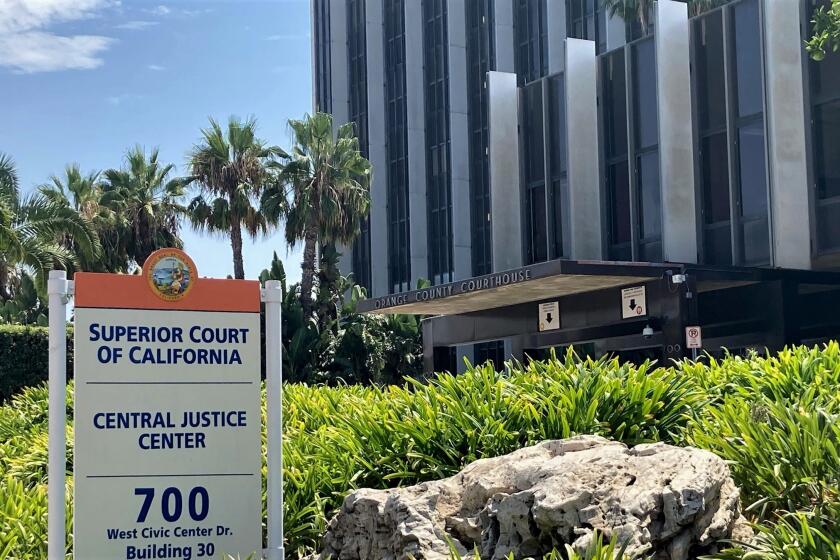Plotting a course for the Westside
- Share via
He lives there. That was enough for Ralph Ronquillo to get involved
with trying to come up with ideas to make life better in Costa Mesa.
He and 27 of his peers are part of the Westside Revitalization
Oversight Committee, known as WROC.
Over the past year, the group -- a clustering-together of
homeowners and commercial and industrial interests -- has come
together to try to create common ground for what the Westside of
Costa Mesa will someday look like. That area is roughly west of
Harbor Boulevard and south of Fairview Park.
Ronquillo, 46, a longtime resident of the city, is chairman of the
committee, which released recommendations last week for revamping the
Westside by combining elements such as the rezoning of the Westside
Bluffs, mixed-used development, regulation and code enforcement,
revitalization incentives, and infrastructure improvements. Those
long-awaited recommendations included zoning that would allow for
more homes to be developed in areas that have been zoned commercial
and industrial.
Ronquillo became involved with the efforts to improve the Westside
a few years ago when community forums were being organized to discuss
the issues facing the Westside area.
At first, he was hesitant about being the committee’s chairman.
But becoming chairman came at a pivotal time. The committee’s
predecessor, the Community Redevelopment Action Committee, had made
general suggestions, but those ideas needed refinement. That would be
the job of Ronquillo’s group. Now, he confidently speaks of the
recommendations’ future, which includes city staff preparing a plan
to put the committee’s ideas into action.
Ronquillo answered some questions from the Pilot’s Ryan Carter.
What are the main tenets/recommendations of the Westside
Revitalization Oversight Committee’s recently released report? How,
in your opinion, will they help revitalize the Westside?
The committee’s report is a comprehensive plan to revitalize the
Westside starting with the area in and around the 19th street
commercial corridor. The report includes some very specific
recommendations in the areas of zoning, code enforcement, improved
infrastructure and incentives that could be implemented with the goal
of attracting interest from private residential and commercial land
development firms. One of the goals of the report is to smooth the
path that would make it economically feasible for these private firms
to work with city leaders in allowing free market economics to
motivate the changes we’re hoping to see on the Westside. We feel
this is a better option than creating a huge financial burden for the
city in order to fund the revitalization.
Was it difficult to reach consensus among the various interests on
the committee to achieve this report? What were the challenges on
agreeing on the recommendations?
Despite the fact that we started with more than 30 members, the
process of actually gaining consensus on the report recommendations
was not as difficult as one might think. One of the biggest
challenges was in building trust. Part of that process meant clearing
away preconceived notions and letting committee members unload their
baggage from previous Westside-related efforts or committees they’ve
been involved with. This process actually became a rallying point and
created a bond among the group. So, even though there were different
points of view within the committee, I think in many ways, we felt
that we were all on the same team.
What are the various interests on the committee, and how many
people are on it?
The committee started with close to 40 members and I believe we
ended up with approximately 27 active members at the end. The
interests on the committee run the gamut of the interests that exist
on the Westside, such as industrial, commercial, and residential
property owners, retail business people, and many individuals who
have been vocal and sometimes quite critical over the years regarding
issues facing Costa Mesa in general and specifically the Westside.
Going back to 1998, there have been various attempts to create
plans to revitalize the Westside, but they haven’t gotten far? Are
you confident these plans will not be shelved?
I am extremely confident that these plans will not be shelved,
primarily because the report reached unanimous consensus approval by
a committee with so many diverse viewpoints. Another reason is that
the Redevelopment Agency membership recently voted unanimously to
approve the report, as well.
For perhaps the first time, there is a simultaneous channeling of
momentum behind this effort both from the community and from city
leadership. In addition, the property we are talking about is
extremely valuable and is only a little more than a mile away from
one of the world’s greatest natural resources -- the Pacific Ocean.
Why was Westside Revitalization Oversight Committee important? Why
did you get involved with it?
The committee was important because we had the right people on the
committee. These are not people who are used to agreeing with one
another. These are people who understand the history of the Westside,
the history of earlier efforts and earlier disappointments and there
was a real feeling that, for the good of our community, it was time
to set aside our differences and work it out face to face. I got
involved because this is where I live.
Describe your ideal vision of the Westside? Why is it important to
revitalize it, and do you have a sense of how much it will cost the
city to implement the changes recommended?
My ideal vision of the Westside is pretty simple. I see a place
that is safe, clean, vibrant and fun -- the kind of place where you’d
want to be any time, day or night. There are several reasons why it
is important to revitalize this part of the city. Number one is
because at present it does not fit with many residents’ ideal visions
of what the Westside should be -- not just mine.
At this point I have no real concept of how much thecommittee’s
recommendations would cost the city to implement -- again one of our
goals was to make it attractive for private industry to get involved
and carry a good portion of the load. One thing I do know is what it
could cost the city if a strong effort is not made to implement these
recommendations. The cost will be in longtime Westside and other
Costa Mesa residents who will throw up their hands and finally
convince themselves that it’s not worth the effort any longer. They
will continue to pull their kids out of our local public schools, to
send them to schools in other cites or private schools, and they may
even move their families to other cities entirely. This trend is
already costing the city by weakening our school sports programs and
creating a fragmented community that is not diverse but divided.
In what time frame do you see revitalization happening?
That’s the beauty of it. It’s already happening. Our city leaders
have already begun the ground-level improvements in terms of
undergrounding utilities and improving streets and landscaping. These
steps are just the beginning -- implementing the WROC’s
recommendations is the next step. It’s going to take time to
revitalize this area. We’re talking years, not months.
What happens to WROC now that a report has been completed? Does it
disband or keep going? If it keeps going, what’s next?
The WROC is not ready to disband just yet. The committee in some
form or another has been invited to be involved in the city’s
implementation planning phase according to our committee liaison,
Council Member Libby Cowan.
Anything I didn’t ask that you’d like to add?
I’d like to invite all the Daily Pilot readers to download a copy
of the report from the city’s website or go down to City Hall and get
a printout. The report is easy to follow and it makes a lot of sense
for our community.
* EDITOR’S NOTE: The city’s website is at
https://www.ci.costa-mesa.ca.us. The Westside Revitalization Oversight
Committee members are Michael Berry, Fred Bockmiller, Mirna Burciaga,
James(Jim)W. Clough, Campbell Davidson, Donald Elmore, Christian
Eric, Kathleen Eric, Chris Fewel, Mary Fewel, Hildegard Gonzales,
Robert Graham, Dan Gribble, Frank Gutierrez, Mike Harrison, Alexander
Hernandez, Lisa Lawrence, Alma Marquez, Steve Marx, Martin Millard,
Ralph Ronquillo, David Salcido, Michael Steiner, Vernon K. Taylor,
Roberto Torres, Edilia Torres, Bill Turpit, Cathy Waters.
All the latest on Orange County from Orange County.
Get our free TimesOC newsletter.
You may occasionally receive promotional content from the Daily Pilot.







